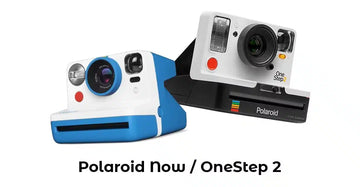Mastering the Polaroid: Understanding Film Capacity and What to Expect
por Дашка Шипунова en Jul 29, 2025

Introduction: The Allure of Instant Photography
Polaroid cameras have long held a special place in the hearts of photographers, both amateur and professional. The ability to capture a moment and have a physical print in your hands mere seconds later is a unique and captivating experience. However, for those new to the world of instant photography, understanding the intricacies of Polaroid film can be a bit of a mystery. How many shots can you expect from a single film pack? What happens when you run out of film? In this comprehensive guide, we'll dive deep into the details of Polaroid film capacity, providing you with the knowledge and confidence to make the most of your instant camera.
Unraveling the Polaroid Film Pack
At the heart of the Polaroid experience is the film pack, a self-contained cartridge that houses the photographic materials necessary to produce those iconic instant prints. Depending on the era and the specific Polaroid model you're using, the film pack can contain a varying number of exposures. Understanding this is crucial to ensuring you never run out of film unexpectedly.
The Evolution of Polaroid Film
- Vintage Polaroid Film: In the early days of Polaroid, the film packs contained 10 exposures. This was the standard for many of the classic Polaroid cameras, such as the iconic Polaroid 600 series.
- Polaroid Originals Film: When Polaroid Originals (formerly The Impossible Project) stepped in to revive the Polaroid brand, they introduced a new film format that contained 8 exposures per pack.
- Current Polaroid Film: Today, the latest Polaroid film packs from Polaroid Originals and Polaroid's own brand continue to offer 8 exposures per pack, maintaining the standard set by the Originals line.
Understanding the Film Counter
One of the most important features of a Polaroid camera is the film counter, a small window or display that indicates how many exposures you have remaining in the current film pack. This counter is designed to provide a visual cue to help you keep track of your film usage.
However, it's important to note that the film counter doesn't always accurately reflect the true number of exposures left. This is because the counter is designed to start at 10 and count down to 0, even though modern Polaroid film packs only contain 8 exposures.
To determine the actual number of exposures left, you'll need to subtract 2 from the number displayed on the film counter. For example, if the counter shows 8, you actually have 6 exposures remaining. When the counter reaches 2, you'll know that you've used up all 8 exposures and it's time to replace the film pack.
Maximizing Your Polaroid Film
Now that you understand the basics of Polaroid film capacity and the film counter, let's explore some tips and strategies to help you make the most of your film and capture stunning instant photos.
Conserve Your Shots
- Avoid Test Shots: It can be tempting to take a few test shots to ensure your camera is working properly, but these will quickly eat into your film supply. Instead, take a moment to carefully compose and frame your shots before pressing the shutter.
- Be Selective: Polaroid film is a precious resource, so approach each shot with intention. Take the time to consider the subject, lighting, and composition before capturing the image.
- Experiment with Bracketing: If you're unsure about the exposure, try bracketing your shots by taking multiple exposures at different settings. This can help you find the perfect balance without wasting too much film.
Maximize Your Polaroid Originals Film
If you're using Polaroid Originals film, there are a few additional tips to help you get the most out of your film pack:
- Understand the Film Counter: As mentioned earlier, the film counter on Polaroid Originals cameras starts at 10 and counts down to 0, even though the film pack only contains 8 exposures. Remember to subtract 2 from the displayed number to get the true remaining exposures.
- Avoid Wasted Shots: When the film counter reaches 2, you'll know that you've used up all 8 exposures. At this point, it's best to avoid taking any additional shots, as the camera won't be able to produce a print.
- Properly Store Unused Film: Polaroid Originals film is sensitive to light and temperature, so be sure to store any unused film packs in a cool, dark place to maintain their quality and longevity.
Troubleshooting and Common Issues
While Polaroid cameras are generally straightforward to use, there are a few common issues that can arise when it comes to film management. Let's address some of these challenges and provide solutions to help you navigate them with ease.
Stuck or Jammed Film
One of the most frustrating problems you may encounter is a stuck or jammed film pack. This can happen for a variety of reasons, such as a film pack that has been loaded incorrectly or a camera malfunction. If you find yourself in this situation, here's what you can do:
- Gently Eject the Film Pack: First, try to gently eject the film pack from the camera. Avoid using excessive force, as this can further damage the film or the camera.
- Check for Obstructions: Inspect the film path in your camera for any obstructions or debris that may be causing the jam. Carefully remove any foreign objects you find.
- Consult the Camera Manual: Refer to your camera's instruction manual for specific guidance on how to clear a jammed film pack. Some models may have special procedures or tools to assist with this issue.
- Seek Professional Help: If you're unable to resolve the problem on your own, it's best to take your camera to a qualified Polaroid repair technician. They'll have the expertise and tools to safely remove the jammed film and get your camera back in working order.
Unexpected Film Exposure
Another common issue with Polaroid film is unexpected exposure or fogging. This can happen if the film is exposed to light or extreme temperatures before or during the development process. To avoid this problem:
- Load Film Carefully: When inserting a new film pack, be sure to do so in a dimly lit environment to prevent premature exposure.
- Protect Developed Prints: Once a print has been ejected from the camera, shield it from direct light until the development process is complete, typically 10-15 minutes.
- Store Film Properly: Keep any unused film packs in a cool, dry place away from direct sunlight or heat sources to maintain their quality.
Embracing the Polaroid Experience
Mastering the art of Polaroid photography is a journey of discovery, creativity, and patience. By understanding the intricacies of Polaroid film capacity and the film counter, you'll be better equipped to make the most of your instant camera and capture those fleeting moments with confidence.
Remember, Polaroid photography is all about embracing the unexpected and celebrating the unique character of each print. Embrace the imperfections, experiment with different techniques, and most importantly, have fun with the process. With a little practice and the right mindset, you'll be well on your way to creating stunning Polaroid masterpieces that you'll cherish for years to come.
Ready to dive deeper into the world of Polaroid photography? Check out our website for more tips, tutorials, and product recommendations to help you get the most out of your instant camera. And don't forget to shop our selection of Polaroid cameras and film to start your instant photography journey today!




